|
Situation:
| An observer is standing in a stationary frame of reference, M. He looks out his window and observes a rocket ship (with a transparent side) passing by. The ship represents a "proper" frame of reference (P). A "proper" light clock, whose photon moves straight up and straight down (when seen by an occupant of the rocket), is affixed to the wall of the rocket and can been seen by the observer in reference frame M. Inside the ship, a ball is moving in the x-direction with a speed, VP, when viewed from reference frame P. The ship is moving past the observer in reference frame M with a speed, u. See diagram below: |
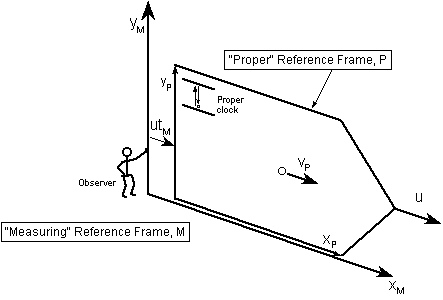
Explanation:
Classically, the positions, velocities and observation times for the ball as viewed from each frame of reference are related as follows:
Galilean (Classical) Transformations
To derive the corresponding relativistic relationships (Lorentz Transformations), the appropriate relativistic corrections must be applied. Under relativistic conditions, as viewed by the observer in reference frame M, XP is decreased (length contraction) by a factor of 1/g, where

|
Applying this "correction" to Eq. 1b yields the equation to the right -->
|
 |
|
Solving for XP:
|
 |
|
It follows that in reference frame P:
|
 |
|
Solving for tP:
|
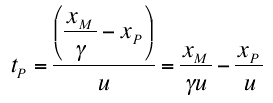
|
|
Substituting in for XP:
|
Which can be simplified to: |

|
 |
|
It follows that in Reference frame M:
|

|
|
For a ball moving Vp in reference frame P:
|
 |
|
What is the speed of the ball as seen by the observer in M? Substituting Eq. 5 into Eq. 3
|
 |
|
And Eq. 5 into Eq. 4
|
 |
|
Therefore dividing Eq. 6 by Eq. 7
|

|
This relationship is the speed of the ball in reference frame P as seen by the observer in M. Note that the top half Eq. 8 is the classical relationship for relative speed. The bottom portion of Eq. 8 is a relativistic "correction factor." If VP is 0.8c and u is 0.9c, the VM is not 1.7c as predicted classically but is "only" 0.998c! The ball is not moving faster than the speed of light.
The Bottom Line:
Lorentz (Relativistic) Transformations:
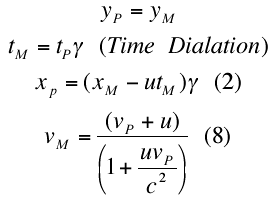
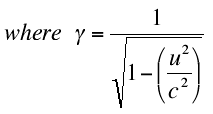
|
Note that in each case when u<<c, the relativistic equation simplifies to the classical expression.
|
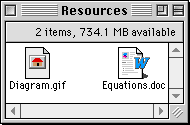
|
|
Text versions of the equation work are made with Microsoft Equation Editor and are embedded in Microsoft Word documents.
|
|
Movies are saved in QuickTime format available at Apple's site. Get Quicktime 4 today!
|
 |
|
|
|













